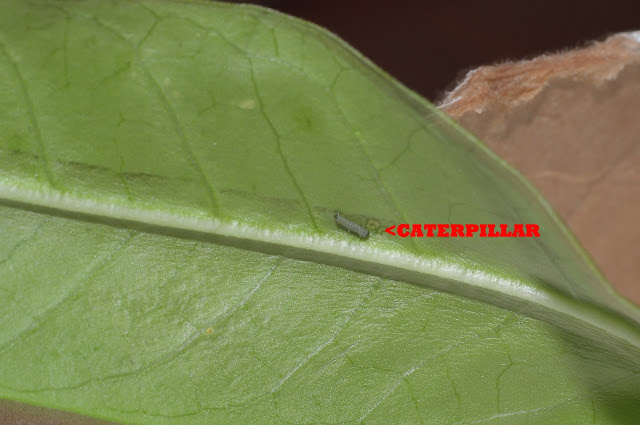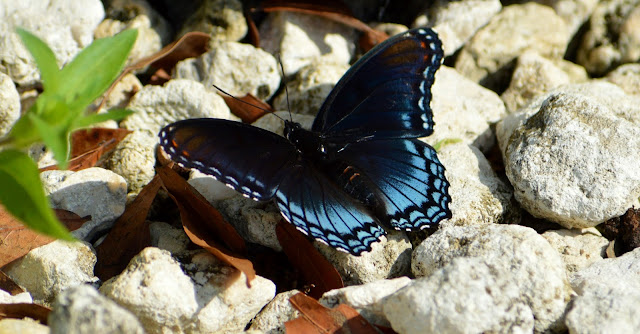Part I: Butterfly to Egg to First Instar Caterpillar
After close to nine months of research about Monarchs, their life cycles, and what their caterpillars eat as well as a lot of hard work planning and planting nectar flowers and host plants in the garden, one of my dreams has come true. I have three Monarchs in the garden at this time. Although several male Monarchs have appeared over the last couple of months, all very beautiful and exciting to behold, I needed females to come and lay eggs and they have finally arrived.
 |
| Male Monarch on a butterfly bush or Buddleia Davidii (< points to one of two black spots, which are scent glands, that only appear on the bottom wing of a male) |
 |
| Female Monarch on Tropical or Mexican butterfly milkweed |
By the first week in July, two females appeared and began laying eggs immediately upon their arrival in the garden. Of course, I had many milkweed host plants waiting on them, some in bloom and some not. Butterfly milkweed, for which there are many varieties, is the only host plant the Monarch caterpillar can eat. I applied and was approved by Monarchwatch.org back in October 2012 to become a Monarch waystation. This required, among many things, that I grow butterfly milkweed for the Monarch caterpillar. Although I realized that Ocala, Florida is not in the direct migration path for the Monarch, I gambled on the fact that the central portion of the peninsula does get strays migrating up and down the length of the state, making their home here. I wondered for many months if these beautiful creatures would grace my garden with their presence.
 |
| Female Monarch on Silky Gold butterfly milkweed. |
I was fortunate to buy five Silky Gold milkweed plants with seed pods in tact last year from the University of Florida's Butterfly Rainforest. I harvested many seeds and saved them for planting in my winter greenhouse. When the last frost was over in March, I was ready to plant several milkweed host plants in various places in the garden. So far, I have succeeded in growing two varieties, Silky Gold, which has a bright yellow flower and Tropical or Mexican milkweed, which has a red and yellow flower.
.JPG) |
| Seeds of the Silky Gold butterfly milkweed plant |
The Monarchs, both female and male, love both of these two plants as I have seen lots of activity and egg laying on both types of milkweed. The female butterflies have no problem finding the right plant, with or without blooms. Usually when a female lays eggs, she appears to be hopping to and from each plant, putting an egg or two on one plant at a time. I have no idea if they even mated with the one male already making his home here.
 |
| Female Monarch laying an egg on Silky Gold butterfly milkweed |













.JPG)



.jpg)

.JPG)





.JPG)


.jpg)













